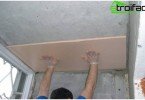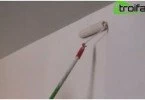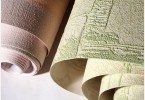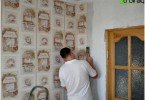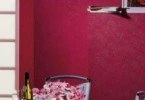How to glue vinyl wallpapers
Among the huge variety of wallpapers, the “vinyl” look is the most popular. This phenomenon is quite justified, because vinyl wallpapers are full of various colors and textures, in addition, they not only look beautiful on the wall, but also wash perfectly, and they do not fade in the sun. And these are excellent indicators that characterize this type of wallpaper exclusively on the positive side. But all this beauty can be replaced by poor final results of gluing, therefore, on the question of how to glue vinyl wallpapers, you need to have a balanced and serious approach.
Content
- Modern vinyl wallpaper – feature.
- Wall preparation.
- Cutting wallpaper: practical recommendations.
- Glue preparation is an important step.
- How to glue vinyl wallpapers – technology
Modern vinyl wallpaper – feature
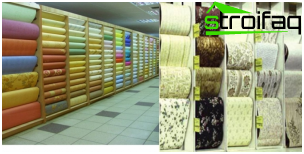
A variety of vinyl wallpapers provides an opportunity to find material for gluing rooms with different operating conditions
Today’s vinyl wallpapers have excellent performance, because they are “breathable”: their upper layer is represented by the finest microporous plastic, and the lower base is made of paper or non-woven.
Vinyl wallpapers are divided into:
– foamed (structural) vinyl;
– silk screen printing;
– vinyl wallpaper with a high degree of moisture resistance;
– embossed vinyl wallpaper.
Wallpaper of foamed and embossed type hides minor irregularities on the wall, and silk-screen printing emphasizes them. This argument must be taken into account before proceeding directly to the gluing..
Despite the fact that vinyl wallpapers look spectacular and beautiful, many people are afraid of such a risky purchase (in their opinion). There is nothing risky in this process, you just need to know how to glue vinyl wallpapers. Then, with a clear understanding of the whole process, all difficulties go by the wayside, and the final result is of high quality..
Wall preparation
Before gluing the wallpaper, first of all, you need to make sure that the wall surface is leveled, there are no cracks, recesses on it, and also the wall is cleaned of the old coating. In order to get rid of old, already boring wallpaper, you should wet the wall and clean it thoroughly with a spatula. And also if there is a need, it is necessary to level and putty the wall surface.
Vinyl wallpapers are glued exclusively to a dry and even wall, which is preferable to be treated with a fungicidal composition to prevent mold and fungus from appearing under the wallpaper. This preventive measure is important, so you don’t need to ignore it..
Important: wallpaper can only be glued indoors without drafts, with the air conditioner turned off and windows closed.
Cutting wallpaper: practical recommendations
The first paragraph of the recommendations is to check the purchased batch of wallpaper for the identity of the pattern, color and batch number. After reconciliation, you can start cutting. The easiest option when there is no pattern on vinyl wallpaper. In this case, the wallpaper panels can be cut without combining the pattern. The required web length is unwound from the roll and carefully cut.
As for the direct docking of the picture, it needs to be combined in advance. It is necessary to be guided by this principle: on each subsequent panel, the pattern is half shifted. So, the stripes will coincide through one. Also, do not forget that all pieces of the canvas should be unwound in one direction from the roll.
Important: when cutting wallpaper into strips, leave an allowance of 10 cm in length.
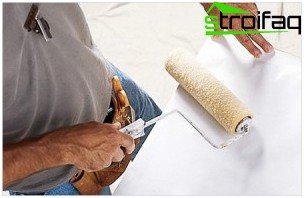
For uniform glue application a roller is required
Glue preparation is an important step
Since the types of wallpaper are different, it means that the glue for their use must also be appropriate. The necessary type of glue is indicated on the packaging of the wallpaper. Its preparation consists in thorough kneading and leaving for a certain period of time in peace for swelling.
The adhesive is applied with a plentiful uniform layer, after which the vinyl wallpaper does not immediately stick. Before you stick the vinyl wallpaper, you need to allow the panel to soak in the adhesive, about 3-5 minutes. The plastered cloth is formed according to the principle of “base to base”.
Important: if this procedure is not performed, the result of negligence will be joints that broke when dried.
During the swelling period, the fibrous parts of the paper base swell, and the wallpaper itself stretches a little. For all bands, the swelling time must be the same. This is very important for the cleanliness of the seams and the perfect appearance of the wallpaper. All these rules apply to paper-based vinyl wallpapers..
Non-woven vinyl wallpaper base is easier to process. When gluing, it is not the back side of the wallpaper that is processed with glue, but the wall, so the impregnation process is not relevant here.
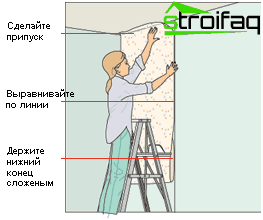
Technology for gluing vinyl wallpapers
How to glue vinyl wallpapers – technology
Sticking the first strip of wallpaper is best to start from the corner. The most convenient way to paste wallpaper together. One person, standing on a stepladder, puts the canvas on the wall and aligns it up, and the second holds the lower end of the strip. At the same time, he stands on the floor and neatly combines the canvas with a vertical line drawn on the wall.
Vinyl wallpapers are always glued end-to-end, that is, without overlapping panels on top of each other. You also need to ensure that the adhesive mixture does not fall on the “face” of the wallpaper. If this happened, then immediately you need to wipe the glue with a dry cloth.
The material that remains under the ceiling and near the baseboard is extremely carefully cut under the ruler with a wallpaper knife. The use of a blunt knife is unacceptable – the wallpaper will be torn. If there is such an opportunity, it is much better to remove the baseboard before gluing the wallpaper, then the edge of the canvas will not need to be bent.
As for the zone of sockets and switches, here, first of all, electricity must be disconnected. Then removed electrical outlets and switches. Wallpaper is glued directly to the holes formed. Later, when the glue dries, you can cut the holes in a cruciform way. Corners in the places of incisions are bent inward. After the work is completed, the switches and sockets are screwed into place.
For radiators, the wallpaper is glued no more than 20 cm behind the heater. If there is a great desire to stick the entire surface of the wall, which is located behind the radiator, then you need to cut strips 10 cm wide, and glue it, pressing them to the wall with a small roller with a long handle. And the best solution is to paint the walls behind the radiators in a tone that matches the color of the wallpaper.
The correct implementation of all these recommendations and tips guarantee a clean and neat appearance of the wallpaper after the final completion of the process.
For the most understandable answer to your question, how to glue vinyl wallpapers – our material will help best. It clearly and clearly indicates the entire process.


